The Intel Core i3-7350K (60W) Review: Almost a Core i7-2600K
by Ian Cutress on February 3, 2017 8:00 AM ESTProfessional Performance: Windows
Agisoft Photoscan – 2D to 3D Image Manipulation: link
Agisoft Photoscan creates 3D models from 2D images, a process which is very computationally expensive. The algorithm is split into four distinct phases, and different phases of the model reconstruction require either fast memory, fast IPC, more cores, or even OpenCL compute devices to hand. Agisoft supplied us with a special version of the software to script the process, where we take 50 images of a stately home and convert it into a medium quality model. This benchmark typically takes around 15-20 minutes on a high-end PC on the CPU alone, with GPUs reducing the time.
Here we report the overall time to complete the test – sub-test results can be found in Bench.
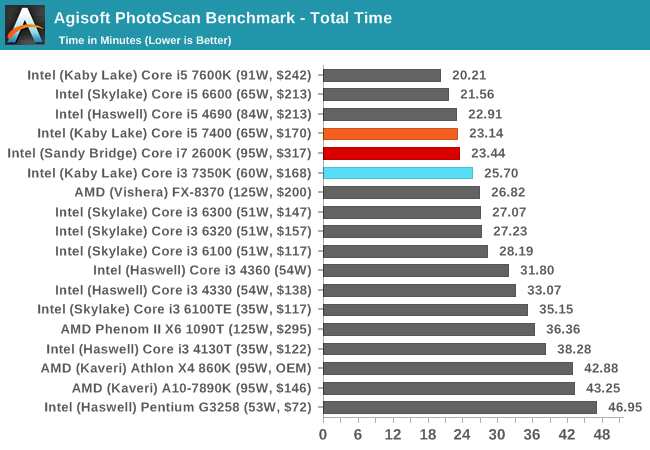
Photoscan is a mix of single and multi-threaded segments, but overall the extra cores in the i5/i7 beat the Core i3, but not by much.
Cinebench R15
Cinebench is a benchmark based around Cinema 4D, and is fairly well known among enthusiasts for stressing the CPU for a provided workload. Results are given as a score, where higher is better.
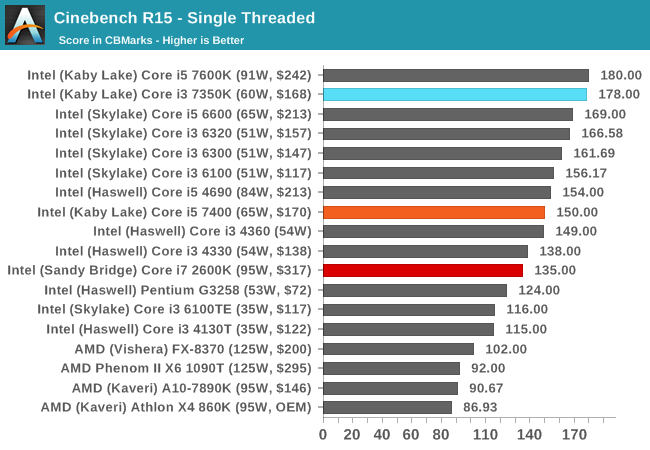
All the Kaby Lake processors seem to do well in CB15 single threaded performance, given that all the K-processors can reach 4.2 GHz or higher one way or another. Nonetheless, the age of the Core i7-2600K is showing here.
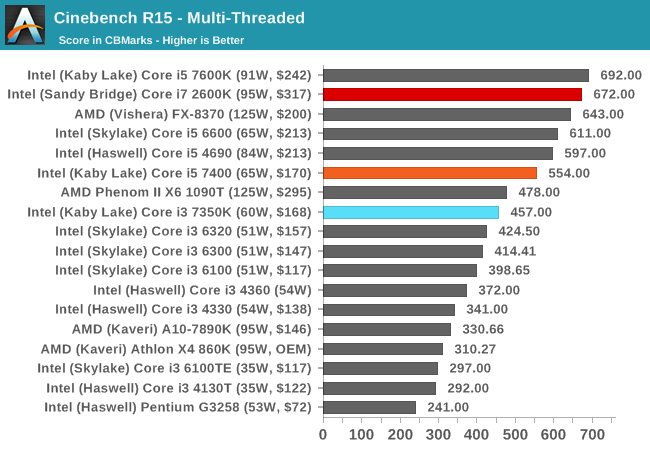
Turning the tables with actual cores, and the Core i7-2600K gets a significant leg up here. The Core i5 also sits above the Core i3.
HandBrake v0.9.9: link
For HandBrake, we take two videos (a 2h20 640x266 DVD rip and a 10min double UHD 3840x4320 animation short) and convert them to x264 format in an MP4 container. Results are given in terms of the frames per second processed, and HandBrake uses as many threads as possible.
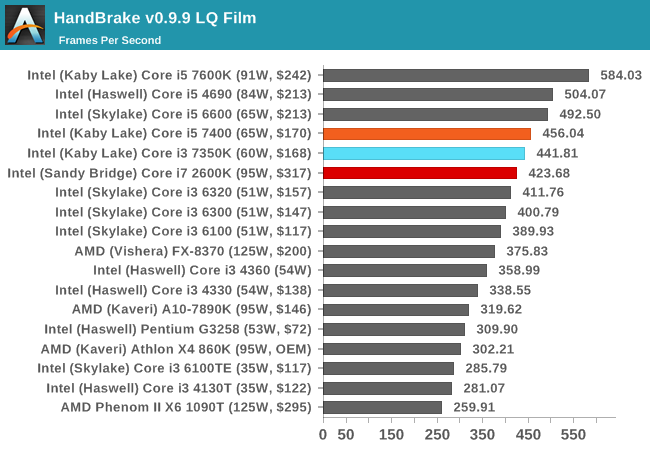

For video conversion, having small frames puts all three CPUs in a similar spot. But ramp up the frame size and we see the Kaby Lake i5 pull ahead due to IPC and instructions. The Core i3 has enough oomph to match the extra threads on the Core i7-2600K though.
Hybrid x265
Hybrid is a new benchmark, where we take a 4K 1500 frame video and convert it into an x265 format without audio. Results are given in frames per second.
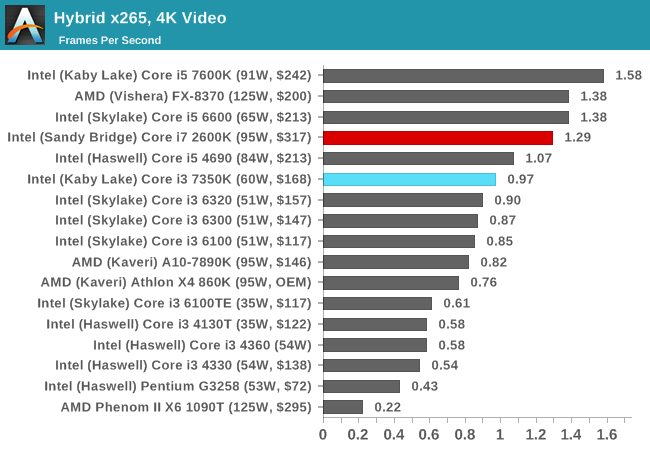
With a different video conversion tool and render, the extra cores and threads of the Core i7 is more than enough to give it a 30% advantage over the Core i3-7350K. It makes me wonder if another +30% frequency would help the Core i3.










186 Comments
View All Comments
Flunk - Monday, February 6, 2017 - link
Yeah, that is funny. I'm using a massively overpowered PSU myself. I have a 850W unit running a system with a moderately-overclocked i7-6700k and Geforce 1070. Had it left over from my previous massively overclocked i5-2500k and dual Radeon 7970s, even if it's aged badly (which it probably hasn't it's only a few years old) it should still be good for ages, especially as under-stressed as it now is.fanofanand - Friday, February 3, 2017 - link
Or you could just get Ryzen with the wraith cooler :)BrokenCrayons - Friday, February 3, 2017 - link
Perhaps when they're available for purchase I'll look into it. I'm interested in seeing what AMD does with mobile Ryzen, integrated graphics, and HBM for CPUs (unlikely) and how it changes laptop computing.fanofanand - Friday, February 3, 2017 - link
The rumor mill has been churning and the consensus is that APU's will be available in 2018 with HBM. That will be a game changer for more than just mobile computing, but for small form factors as well. At least theoretically, experience tells me we should wait for reviews before deciding how profound the impact will be.Flunk - Monday, February 6, 2017 - link
The Wraith cooler is both marginal and loud compared to quality aftermarket coolers that cost as little as $35. Sure it's better than the last AMD stock cooler, but that's more a case of the last AMD stock cooler being total garbage.bananaforscale - Wednesday, February 8, 2017 - link
Hey, no dissing huge air coolers! :D (Yeah, I have one and it's so big it largely dictated the case selection. Does keep a hexcore Bulldozer at 52 degrees at 4 GHz tho.) There's also the niggle on Intel side that their enthusiast line has only made it to Broadwell-E, so that's what I'll be upgrading to. A huge upgrade in IPC (which probably won't rise much in the next years), more cores and lower power use per core. I figure I'll be upgrading next around 2025. :D I'm pondering whether I should go AIO liquid or custom...MonkeyPaw - Friday, February 3, 2017 - link
More emphasis is going into the IGP.CaedenV - Friday, February 3, 2017 - link
I doubt it is competition. I mean, lack of competition certainly explains the price per performance not coming down even though the manufacturing costs are getting cheaper, but I think that we have hit a performance wall.With every die shrink we can get more performance per watt... but the die is also more heat sensitive which kills stability for higher clocks. The idea that you can hit 5GHz on the new chips is nothing short of a miracle! But without a major increase in clock speed, then your performance is limited to the instruction sets and execution model... and that is much harder to change.
And that isn't hard to change because of competition. That is hard to change because PCs live and die by legacy applications. If I can't go back and play my 20 year old games every 3-4 years then I am going to get rather annoyed and not upgrade. If businesses can't run their 20 year old software every day, then they will get annoyed and not upgrade.
I think we are rather stuck with today's performance until we can get a new CPU architecture on the market that is as good as ARM on the minimum power consumption side, but as efficient as x86 on the performance per watt side... but whatever chip comes out will have to be able to emulate today's x86 technology fast enough to feel like it isn't a huge step backwards... and that is going to be hard to do!
xenol - Friday, February 3, 2017 - link
Anandtech please do frame-time tests as well for games. Average frame rate is good and all, but if the processor causes dips in games that could lead to an unpleasant experience.Mr Perfect - Friday, February 3, 2017 - link
I would also be interested in seeing this.The site slips my mind, but somewhere tested multiple generations of i7s, i5s and i3s for minimum framerate and even the oldest i7s had a more consistent framerate then the newest i3s. It would be interesting to get AT's take on this.